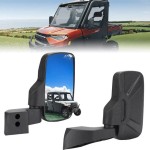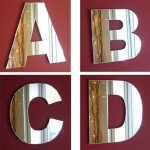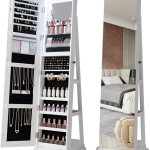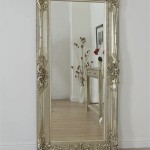How To Hang A Mirror On An Angle
Hanging a mirror at an angle introduces a dynamic element to interior design. It can create interesting reflections, enhance natural light distribution, and add a unique touch to any room. However, hanging a mirror on an angle requires a different approach than traditional straight hanging.
Before beginning, gather the necessary tools and materials. These typically include a measuring tape, pencil, level, drill with appropriate drill bits, suitable wall anchors (if necessary), a screwdriver, the angled mirror hangers of choice, and the mirror itself.
The specific type of angled hanger will depend on the mirror's size, weight, and the desired angle. Several options exist, including adjustable D-ring hangers, angled cleat systems, and specialized offset clips. Carefully consider the manufacturer's weight recommendations for each hanger type to ensure secure mounting.
Accurate measurements are crucial for achieving the desired angle. Begin by determining the desired angle of the mirror. This can be visualized or sketched beforehand. Use a protractor or angle finder to ensure precision. Once the angle is established, mark the corresponding points on the back of the mirror where the hangers will be attached.
Attach the chosen angled hangers to the back of the mirror according to the manufacturer's instructions. Ensure screws are firmly tightened and the hangers are securely attached to the mirror's frame or backing. Double-check the alignment of the hangers to maintain the intended angle.
The next step involves transferring the hanger positions and angle to the wall. Hold the mirror against the wall at the desired height and angle. Use a pencil to lightly mark the top and bottom edges of the mirror on the wall. This will serve as a guideline for positioning the hangers.
With the mirror removed, carefully measure the distance between the hangers on the back of the mirror. Using this measurement and the previously marked top and bottom edges, transfer the hanger positions onto the wall, maintaining the correct angle. A level and angle finder can be used to ensure accuracy.
Once the hanger positions are marked on the wall, determine if wall anchors are required. This depends on the wall material and the weight of the mirror. Consult a professional if unsure. If anchors are necessary, drill pilot holes and insert appropriate wall anchors.
Now, align the screws or mounting hardware of the wall-mounted portion of the chosen hanger system with the marked positions on the wall. Securely fasten the wall-mounted portion of the hangers, ensuring they are flush with the wall.
Carefully lift the mirror and engage the hangers on the back of the mirror with the wall-mounted portions. Depending on the hanger type, this might involve hooking, slotting, or clipping the two parts together.
Once the mirror is hanging, thoroughly check its stability. Gently push on different areas of the mirror to ensure it is securely mounted and won't shift or tilt. Use a level to verify the desired angle is maintained.
Different angled hanger systems offer various adjustment options. Some allow for fine-tuning the angle even after the mirror is hung. If available, utilize these adjustment mechanisms to perfect the mirror's position and angle.
Lighting plays a significant role in the effect created by an angled mirror. Consider how the angle influences reflections and light distribution within the room. Adjust surrounding lighting fixtures or introduce new light sources to enhance the desired effect.
Regularly inspect the mirror and its hanging hardware for any signs of loosening or damage. Tighten screws or replace any worn components as needed to maintain the mirror's secure placement and prevent accidents.
Safety should always be a primary concern. When working with power tools, wear appropriate safety glasses. Use caution when handling heavy mirrors and enlist assistance if needed. Ensure the chosen hanging hardware is appropriate for the weight of the mirror and the wall material.
The technique for hanging a mirror on an angle can be adapted for various mirror sizes, weights, and desired angles. Always carefully consider the specific requirements of each project and select the appropriate tools and hardware accordingly.
Choosing the right angled hanger depends on multiple factors. The weight of the mirror is a key consideration. Heavier mirrors require more robust hangers. The angle of the tilt also influences the type of hanger needed. Steeper angles might require specialized hardware. The wall material is another important factor. Different wall materials require different types of anchors and screws.

How To Hang A Mirror At An Angle Hunker

How To Hang A Frameless Mirror On The Wall With Pictures
How To Hang A 100 Pound Mirror On Drywall Quora

All In The Detail Quick Tip Hanging A Heavy Mirror

Solved How To Hang A Heavy Mirror Bunnings Work Community

How To Hang A Wall Mirror Easy Mounting Instructions

Hanging A Mirror Or Other Object In The Corner Rozy Home

Hanging A Large Mirror On The Wall Tutorial

How To Put A Mirror On An Angled Wall Over Bathroom Sink Vanity

How We Hung This 500lb Antique Mirror Architectural Angle Method








